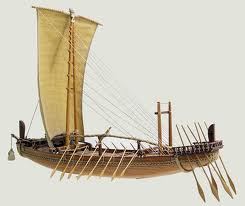Bulbous shape, the "round ships" Phoenicians were better suited to trade than the narrow galley.
Shipyards the most famous were those of the ancient Phoenicians, the great navigators of the Mediterranean. During the second millennium BC. BC, the people built warships and merchant vessels capable of carrying heavy loads. The latter showed bulging forms and had the look of! "Round ships". They were propelled by their sails, the oars being used only in the vicinity of ports. These merchant ships were offering a cargo capacity much larger than the narrow galleys. Thanks to their boats, the Phoenicians sailed across the Mediterranean.
Shipyards the most famous were those of the ancient Phoenicians, the great navigators of the Mediterranean. During the second millennium BC. BC, the people built warships and merchant vessels capable of carrying heavy loads. The latter showed bulging forms and had the look of! "Round ships". They were propelled by their sails, the oars being used only in the vicinity of ports. These merchant ships were offering a cargo capacity much larger than the narrow galleys. Thanks to their boats, the Phoenicians sailed across the Mediterranean.
Bauchige Form, den "runden Schiffe" Phönizier waren besser geeignet als die engen Kombüse Handel.
Werften der berühmtesten waren die der alten Phönizier, die großen Seefahrer des Mittelmeers. Während des zweiten Jahrtausends v. Chr.. BC, bauten die Menschen Kriegsschiffe und Handelsschiffe in der Lage Tragen von schweren Lasten. Letzterer zeigte Vorwölbung bildet und hatte das Aussehen von "Round Schiffe". Sie bestechen durch ihre Segel waren angetrieben, wobei das Ruder nur in der Nähe des Hafens verwendet. Diese Handelsschiffe boten eine Ladekapazität viel größer als die schmale Galeeren. Dank ihrer Boote segelten die Phönizier über das Mittelmeer.
Werften der berühmtesten waren die der alten Phönizier, die großen Seefahrer des Mittelmeers. Während des zweiten Jahrtausends v. Chr.. BC, bauten die Menschen Kriegsschiffe und Handelsschiffe in der Lage Tragen von schweren Lasten. Letzterer zeigte Vorwölbung bildet und hatte das Aussehen von "Round Schiffe". Sie bestechen durch ihre Segel waren angetrieben, wobei das Ruder nur in der Nähe des Hafens verwendet. Diese Handelsschiffe boten eine Ladekapazität viel größer als die schmale Galeeren. Dank ihrer Boote segelten die Phönizier über das Mittelmeer.
Bateau rond phénicien
De forme ventrue, les "bateaux ronds" phéniciens étaient mieux adaptés au commerce que l'étroite galère.Les chantiers navals les plus illustres de l'Antiquité furent ceux des Phéniciens, grands navigateurs de la Méditerranée. Au cours du IIe millénaire av. J.-C., ce peuple construisit des navires de guerre, ainsi que des embarcations marchandes capables de transporter de lourdes charges. Ces dernières présentaient des formes ventrues et avaient l'allure de "!bateaux ronds!". Elles étaient propulsées grâce à leurs voiles, les avirons n'étant utilisés qu'au voisinage des ports. Ces navires de commerce offraient un volume de chargement beaucoup plus important que celui des étroites galères. Grâce à leurs bateaux, les Phéniciens naviguèrent sur toute la Méditerranée.







